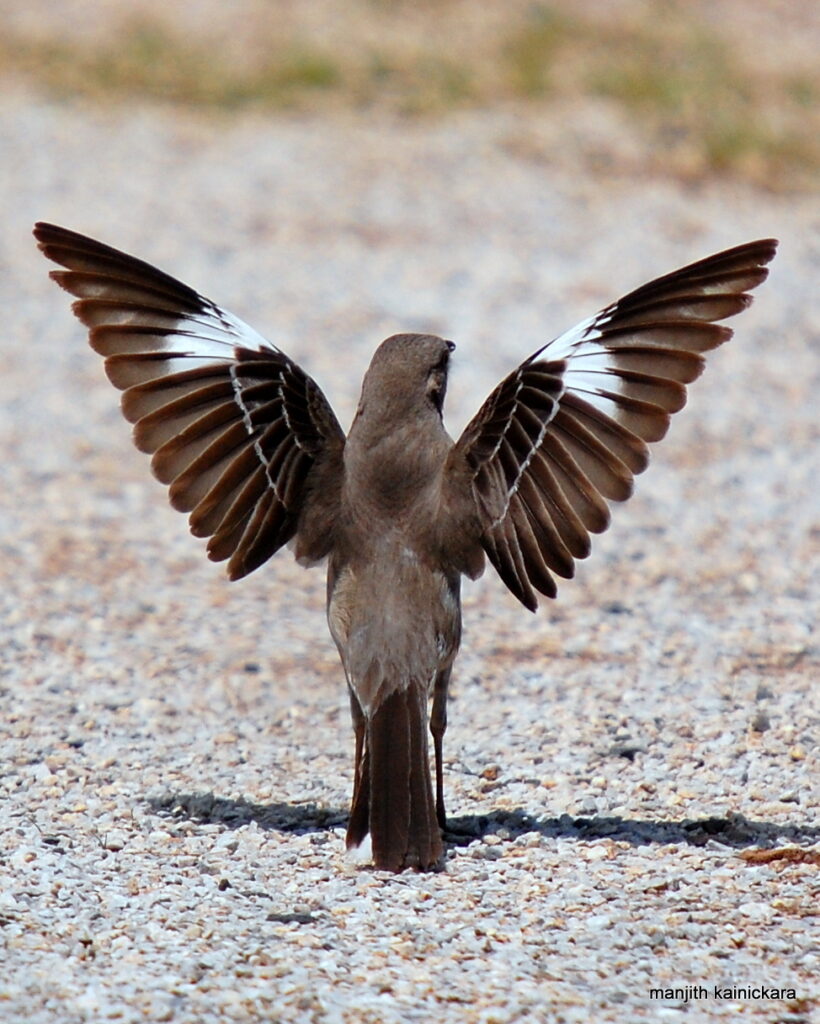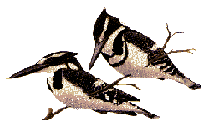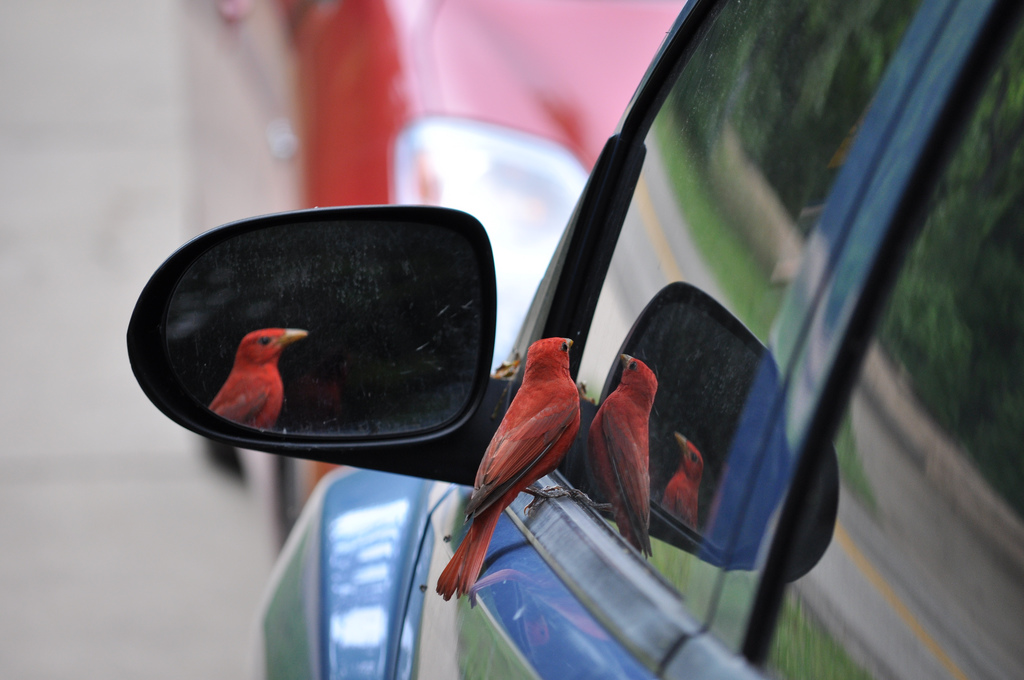
A home range is anywhere a bird happens to wander – basically anywhere in its appropriate habitat. A territory is a defended area within that home range and is is typical of songbirds but it is also found in a number of other orders of birds. A territory may be held by one bird, a pair, or a flock. It may be held for all or only part of a year. It may be very large such as those held by eagles and provide all the resources the bird needs or only a part and be very small such as nesting territories of cliff-nesting birds such as kittiwakes. It may be vigorously defended or loosely guarded. Depending on the abundance of the resources, a territory might be closely held one year and not at all the next. Typically, territories are defended against others of the same species but may also be defended against other species.
Northern Mockingbird Display
What are the kinds of territories?
| 1. All-purpose – breeding season: mating, nesting, feeding (songbirds) |
| 2. Mating and nesting – Red-winged Blackbirds, Tree Swallows |
| 3. Mating – Sage Grouse |
| 4. Nesting – colonial waterbirds |
| 5. Non-breeding (feeding) – Robins in winter |
| 6. Group – various reasons – Acorn Woodpecker |
| 7. Roosting – mixed flocks such as Starlings, Blackbirds |
Territories are defended because the territory contains resources that are in short supply and it costs energy to defend. In 1964 Brown developed a model of territoriality that says when resources are in short supply and the greater the population size the greater the competition for resources. And the more resources needed, the greater the effect the population size has. A lot of competition requires a lot of aggressiveness to obtain the resources. But if it costs too much – economic defensibility- then territories are not held.
Territoriality requires visual and vocal displays and movement. The individual exposes itself to aggression from other birds and predators. For such behavior to evolve, survival and reproductive success must be improved. This increased success results from the more or less exclusive use of an area for the individual and its mate or mates. Benefits come from improved exploitation of resources, lowered diseases and predation rates.
For example, Brewer’s Blackbird nests are preyed upon more frequently when the nests are closer together – territories serve to spread them apart. In the case of colonial nesters, however, such as egrets, swallows, and many seabirds, the individual territories are very small but the colony itself is large and serves to deter predators.
Purposes of Territories:
1. Provides nest sites – holes (nuthatches, bluebirds, wrens); posts or tree snags (Osprey); cliff ledges (sea birds, Peregrine Falcon). Here the nest sites are chose and the territory established around it.
2. Pair formation facilitation – the male can advertise for and attract a female with a quality territory and perhaps nest. Yellow-headed Blackbirds and Red-winged Blackbirds.
3. Reduce disease and predation – this is probably an effect of territoriality rather than a reason for it.
4. Reduction of aggression. Once territories are established, birds know their relationship to one another and territory maintenance is established and there needs to be little competition for resources.
5. Stability of resources – since resources are in a territory, they are predictable.
6. Population control – again, an effect rather than a cause of territoriality. The most successful birds breed but not everyone does – rather than everybody depleting resources. (There are floater and immature males on the fringes waiting to breed.)
Rrsearchers studied the growth of nestling Pied Flycatchers and found that under favorable conditions both high and low density breeding populations did well, but when the weather was bad and/or the food scarce, the low density populations had better success in raising young. Stenger (1958) found a direct correlation between food supply and territory size; the more food available, the smaller the territory and the more there were. The size of the territory, then, is generally determined by population size and resource availability. But there are lots of modifications to this general rule.
Kendeigh’s House Wren studies showed that increased population size results in decreased territory size, up to a point.
# of Pairs Area of Territory(hectares)
7 .32
8 .17
25 .14
42 .12 (minimum compressibility)
The size of territories varies with the individual, the species, and the environmental conditions. Most territories tend to be more or less circular but the shape varies. Stream bank feeders such as the kingfisher have linear territories. Birds that feed on animal food have larger territories than those that feed on plant food. So there are maximum and minimum sizes of territories, the maximum size being controlled by defensibility and the minimum by density of resources.
The amount of aggressiveness in defense of the territory also varies. It may be more advantageous to strongly defend a high quality territory than weakly defend a poor one.
There has been, in recent years, evidence for facultative territoriality. Townsend Solitaires hold territories or not depending upon: juniper berry crop density, accessibility, and competitor populations. (Lederer)
So far we have been talking about intraspecific territoriality among the same species, which is most common. There is some interspecific competition between different species as well, however. As a rule, birds of one species will tolerate birds of other species in their territories and chase out only conspecifics. A Bald Eagle and a Great Horned Owl, e.g. nested in the same tree in Florida only one meter apart. Swallows often nest in eagle and hawk nests. Birds often chase other birds out of their territories if they are potential competitors or predators. Oystercatchers, e.g. will chase gulls, ravens, and crows from their territories.
The influence of territoriality on populations may be great and some individuals may be forced into suboptimal habitats where they are unable to breed. Territoriality may thus cause an increase in the mortality of adults and/or young or a decreased success rate of hatching/fledging. A Finnish study of the Willow Warbler which prefers spruce-birch forests showed that in years of low abundance of this species, almost all pairs of breeding warblers were found in the spruce-birch forest. In times of high abundance, the warblers were found in other habitats also, but their highest density was in spruce-birch. Thus population densities are much higher in sub-optimal habitats in high-abundance years. In high abundance years, the territory numbers increased only slightly and sizes become slightly smaller so more would fit in optimal habitats. So territoriality forced birds into suboptimal but adequate habitats.
Since the number of territories in a given year may reach its maximum in peak years, there may be “extra” individuals -floaters- without territories. In 1951 Hensley and Cope shot all the male warblers of an eastern spruce-fir forest and found that they were almost all immediately replaced. Replacement is usually, but not always, restricted to males.
Territories obviously affect the social system of birds. The male Fiery-throated Hummingbird of Costa Rica and Panama holds a territory; the female is attracted to the flowers in that territory, but feeds on different flowers than the male. The female selects the territories on the basis of the best food source (rather than the attractiveness of the male). Thus the male that is most aggressive is selected for by evolution.
The Marsh Wren is polygamous, the male mating with 1, 2 or 3 females. The sex ratio is 1: 1, so some males go without mates. Again, the females select the males on the basis of the quality of the territory – food and nest sites. The females will share a male rather than choosing an unmated male if the former male has a better territory than the unmated male in a marginal one.
There seems to be a hormonal basis for territoriality; testosterone.Experiments were done with hormonal implants of testosterone by Wingfield of the U. of Wash. on Song Sparrows. Birds were implanted with testosterone tablets to keep their testosterone levels up; these birds were more aggressive and held larger territories. But high testosterone levels are incompatible with parental care, so fledging success went down.
Why do some birds repeatedly fly into windows, glass doors, and automobile mirrors?
When birds establish territories in the spring, they do so by chasing out intruders. The birds they are most concerned about are those of their own species because birds of the same species compete for the same resources – nest sites, food, mates, etc. Once the territory is established, it is maintained by singing and chasing intruders, often very vigorously. Any objects such as windows and glass doors and auto mirrors which reflect the bird’s image give the territorial bird the impression that there is another bird in their territory. And since it is usually the male that establishes and defends territories, other males are the greatest threat, and, of course, a male sees another male in the window or mirror.
It seems that they do not quickly learn the other bird is a reflection and will repeatedly fly against the door, window or mirror, occasionally injuring themselves. They will eventually stop, either because they finally learned the image is no threat or it is not necessary to continue to defend a territory as the young have left the nest. What can you do? The answer is simple but may not be easy to accomplish: eliminate the reflection.
|
|


Hello, I am curious to find out who coined the terms for the different territories. If I wanted to read more about the topic, who should I study?
Every ornithology textbook has good information on territories. Search google for Avian territories and for more scientific information search google scholar for research papers. I believe Margaret Nice created the first categories of territories about 1947.
Thank you, Dr. Lederer. I have searched the net since posting the comment and have found material by Nice and Brown which I would love to read but these online journals today are very expensive. To think, Nice and Brown most likely wrote the material to be shared by everyone and now some company is reaping the benefits of someone else’s work. Thanks for your help. The search Continues.
Is there a site where I can find or read the following two research papers?
Nice, M. M. 1941. The role of territory in bird life. Am. Midl. Nat. 26:441–487.
Nice, M. M. 1943. Studies in the life history of the Song Sparrow. II. The behavior of the Song Sparrow and other passerine birds. Trans. Linn. Soc. N.Y. 6:1–328.
I am trying to find published studies on territories of birds and the only place I can find anything written about them is on this site and Wikipedia. Wikipedia clearly defines 6 territories as this site does but where did these ideologies come from?
My apologies I decided to leave two comments to explain my problem.
On this site, it states that 1. is the All-purpose territory which Wikipedia calls Type A. This territory is called Type A also by Wilson 1975 and Mayr 1935. The problem occurs in the slight differences between Type C and Type D. This site states that 3. is for mating and 4. is for nesting. Which I assume 4. includes the nest and the small area surrounding the nest. Wikipedia reverses these territories and says Type C is used for nesting, including the surrounding area and Type D which is used for mating and pairing. Mayr 1935 supports this sites views on territory and Wilson 1975 supports Wikipedia. Or I should say Wikipedia supports Wilson.
My question is why is there a slight difference between authors? I would write more but I am afraid of taking up too much time. Mayr and Wilson have differences in other territories.
Hi Ryoh. The explanation lies in the fact that the authors try to define territories in a few simple categories when in reality, all territories differ by a little in one way or another. I’m sure you can find differences between different species of gulls, for example. So there is some difference in the interpretation of the various authors. Wikipedia, in my opinion, is a pretty good source of ornithological information but if you want to dig into the subject matter in detail, go to Google Scholar and search for scientific papers. I’m sure you can find considerable information on the topic. For example: Changes in the size of avian breeding territories in relation to the nesting cycle by Anders PapeMøller and Sizes of Feeding Territories among Birds by Thomas W. Schoener. And a lot more.
I see! Said the blind man. I should say of course. Slight differences occur in many of the raptors I research. So many tiny details which separate species are in turn the tiny details which cause the differentiation in territories. Once again, I appreciate your time and the valuable insight. Thank you.
Pingback: Explore The Generous Nature Of Cardinals: Why They Feed Other Birds And How To Encourage Them In Your Own Backyard - Know More Stuff
Pingback: Why Do Birds Fly into Windows? (Find answers now) - Pet Friendly
Pingback: Will Eagles Attack Humans: Understanding the Nature of Eagle
Pingback: Opinion | A Backyard Struggle for Survival Between Birds - Web Today
Pingback: Opinion | A Backyard Struggle for Survival Between Birds - Elite News
Pingback: Can 2 Female Cockatiels Be In The Same Cage? Discover the Answer
Pingback: What Do Cockatiels Look Like? This Will Astound You!
Pingback: Male Cardinals Vs Female Cardinals: Male vs Female Comparison
Yeah! Finally I got it.
Basically I was in search to the answer of question Why do some birds repeatedly fly into windows, glass doors, and automobile mirrors?
Which i found here. Really a comprehensive answer I found. Thank you for sharing this helpful information.